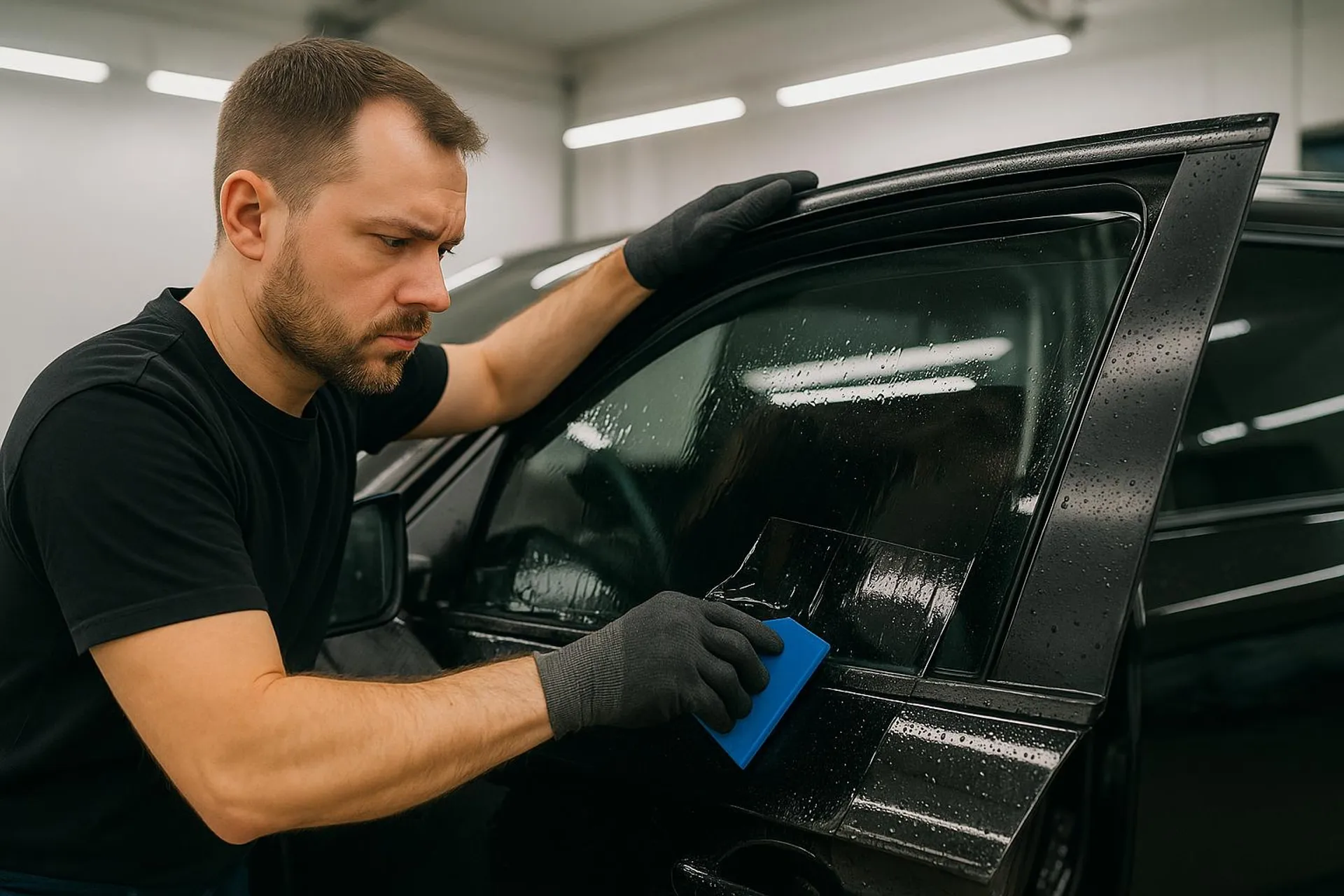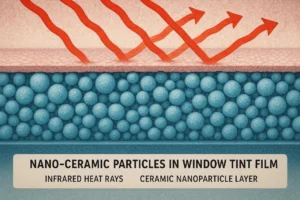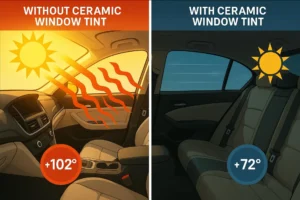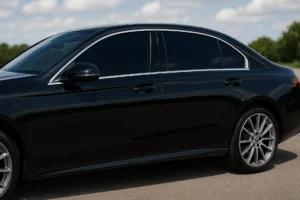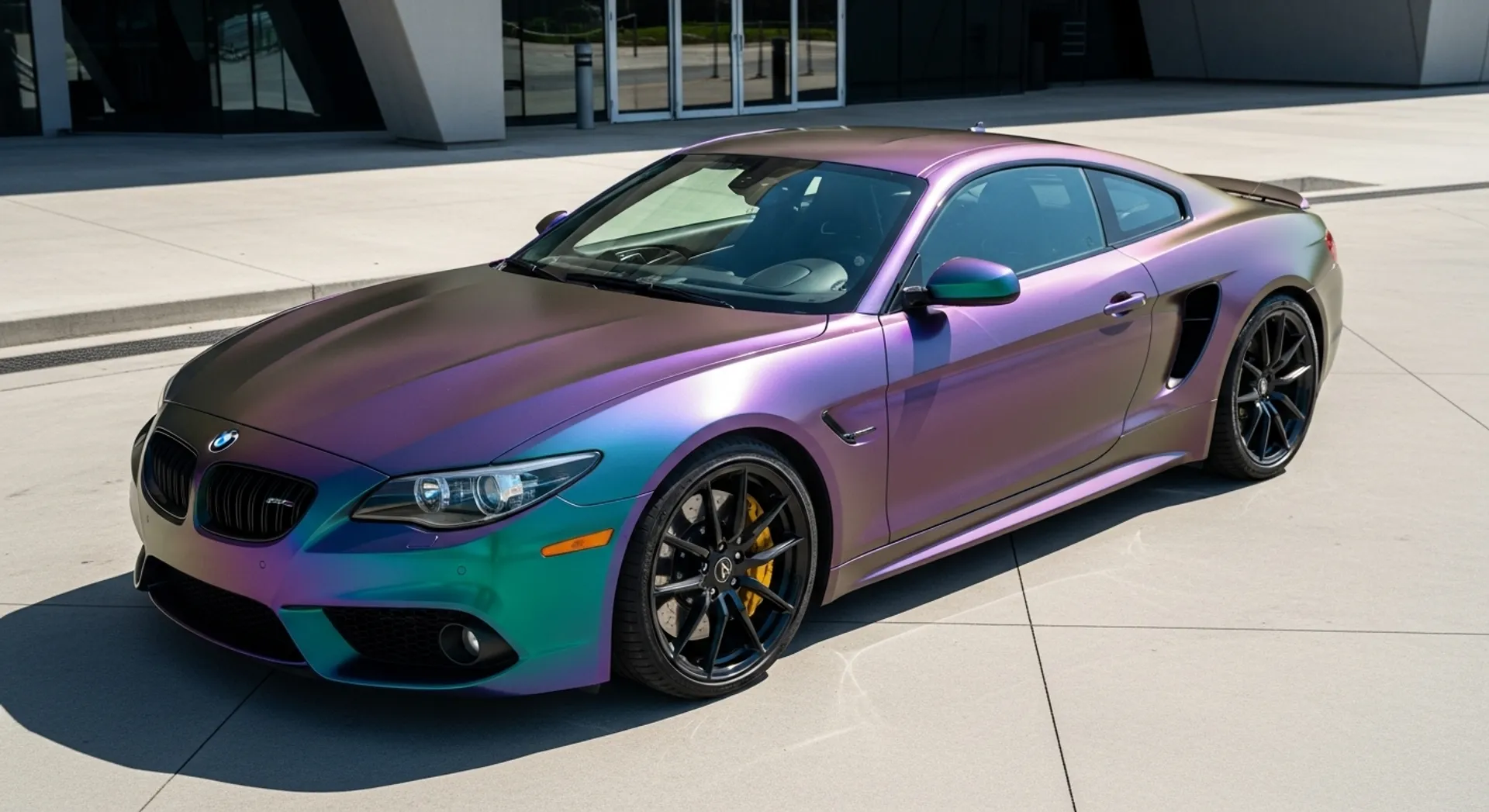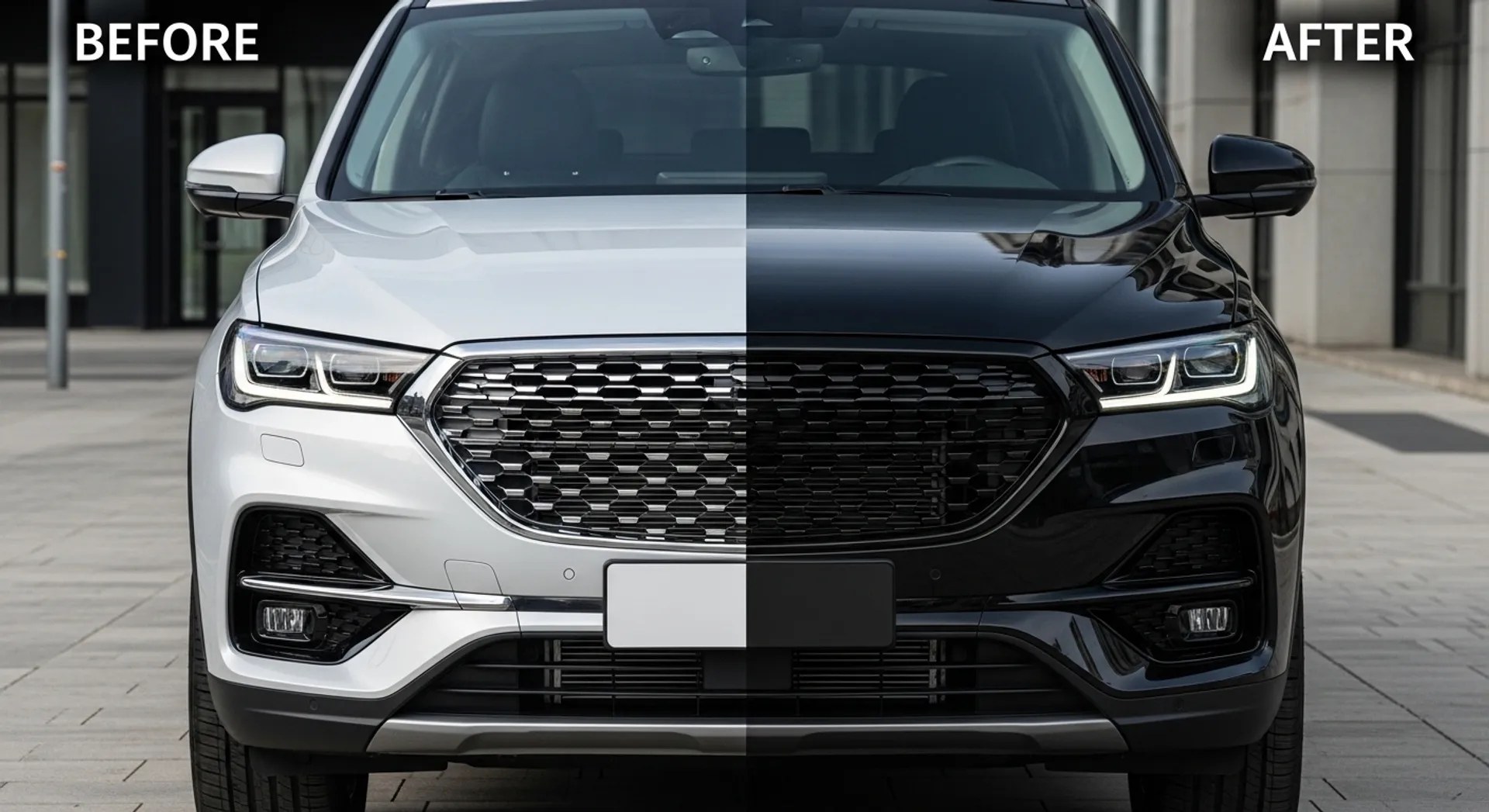Window tinting technology has undergone a revolutionary transformation in recent years, evolving from basic dyed films to sophisticated ceramic and nano-ceramic systems that deliver unprecedented performance across multiple dimensions. The window tinting landscape of 2025 is dominated by advanced materials that provide superior heat rejection, comprehensive UV protection, and exceptional optical clarity while maintaining the aesthetic benefits and privacy that have always made tinting popular. Window tinting services utilize cutting-edge ceramic and nano-ceramic technologies to deliver results that exceed traditional tinting in every measurable category, transforming your driving experience through science-backed performance.
The shift toward ceramic-based window films represents far more than incremental improvement — it constitutes a fundamental leap in performance that addresses the inherent limitations of older tinting technologies. Traditional dyed and metalized films, while still available and suitable for basic applications, simply cannot match the heat rejection capabilities, optical clarity, signal transparency, and longevity of modern ceramic formulations. As consumers become increasingly educated about tinting technology and more demanding in their performance expectations, ceramic and nano-ceramic films have established themselves as the new standard for quality installations. Understanding the differences between tinting technologies and the specific benefits of advanced films empowers vehicle owners to make informed decisions that maximize their investment and deliver tangible improvements in comfort, protection, and vehicle preservation.
The Science Behind Ceramic Window Tint Technology
Ceramic window tint achieves its remarkable performance through nano-ceramic particles embedded within the film’s multilayer structure. These microscopic ceramic particles, measured in nanometers, are engineered to selectively block infrared radiation — the primary wavelength responsible for heat transfer through glass — without requiring metallic content that can interfere with electronic signals. This non-metallic composition represents a crucial advantage over older metalized films that could cause connectivity issues with GPS navigation, cellular phones, satellite radio, and other wireless technologies that modern vehicles depend upon. The ceramic particles are so infinitesimally small that they don’t affect optical clarity or create any visible texture, allowing for crystal-clear visibility even with darker tint shades that provide maximum privacy and glare reduction.
The heat rejection capabilities of premium ceramic tint are genuinely impressive and scientifically measurable. Leading ceramic films from manufacturers like 3M Ceramic IR Series, Llumar CTX, and SunTek CXP can block up to 60-70% of total solar energy while simultaneously allowing high levels of visible light transmission. This remarkable performance means you can achieve significant heat reduction with lighter tint shades that maintain excellent visibility for safe driving and comply with legal visible light transmission requirements. The result is a measurably cooler, more comfortable cabin that requires substantially less air conditioning to maintain pleasant temperatures, improving fuel efficiency in conventional vehicles and meaningfully extending driving range in electric vehicles where climate control represents one of the largest energy consumers.
The molecular structure of ceramic particles creates an incredibly smooth surface at the microscopic level, contributing to the film’s exceptional optical properties. Unlike dyed films that can appear hazy or create color distortion, ceramic tints maintain remarkable color neutrality and clarity. The view through quality ceramic tint is so clear that many drivers report forgetting their windows are tinted until they notice the heat rejection benefits or reduced glare. This optical excellence is particularly important for safety-conscious drivers who refuse to compromise visibility, as it ensures that tinting enhances rather than impairs your ability to see clearly in all lighting conditions, including challenging night driving situations where inferior films can create dangerous visibility limitations.
Nano-Ceramic Technology: Pushing Performance Boundaries
Nano-ceramic technology represents the cutting edge of window film development, utilizing even smaller ceramic particles arranged in more sophisticated three-dimensional patterns to maximize performance across all metrics. The “nano” designation refers to particles measured in nanometers — billionths of a meter — that can be more densely packed within the film’s multilayer structure without compromising optical clarity or flexibility. This increased particle density enhances infrared heat rejection while maintaining or even improving visible light transmission, creating films that can achieve superior cooling performance with lighter appearance. Nano-ceramic films also demonstrate exceptional durability, resisting fading, bubbling, delamination, and degradation even under intense sun exposure, extreme temperature fluctuations, and the mechanical stress of daily window operation.
The optical properties of nano-ceramic films deserve special emphasis, as they represent one of the technology’s most significant advantages. Unlike dyed films that inevitably fade to purple or brown as UV exposure breaks down organic dyes, nano-ceramic films maintain perfect color neutrality and clarity throughout their entire lifespan. The view through nano-ceramic tint exhibits minimal distortion, no color shift, and exceptional clarity that rivals untinted glass in visual quality. This optical performance is particularly valuable for drivers who prioritize visibility and safety, as it ensures that tinting provides benefits without creating the visibility compromises associated with lower-quality films. Night driving visibility through nano-ceramic tint is noticeably superior to traditional films, reducing eye strain and improving your ability to detect pedestrians, road hazards, and other vehicles in low-light conditions.
The advanced engineering of nano-ceramic films extends beyond particle technology to include sophisticated multilayer construction that optimizes performance. Premium nano-ceramic films incorporate multiple functional layers — each engineered for specific purposes such as UV blocking, infrared rejection, scratch resistance, and adhesive bonding. This layered approach allows manufacturers to optimize each performance characteristic independently, creating films that excel across all dimensions rather than requiring compromises between competing goals. The result is window tint that simultaneously delivers maximum heat rejection, comprehensive UV protection, superior optical clarity, and exceptional durability — performance that would be impossible to achieve with simpler single-layer film constructions.
Color-Stable Films: Eliminating the Purple Fade Problem
One of the most common and frustrating complaints about traditional window tint involves the inevitable fading to purple or brown that occurs as UV exposure degrades organic dyes over time. This color shift not only looks unattractive and dates your vehicle’s appearance, but it also indicates that the film is losing its protective properties and heat rejection capabilities. Color-stable ceramic films completely eliminate this problem through their non-dyed construction that relies on ceramic particles rather than organic pigments for light absorption and heat rejection. Because ceramic particles are inorganic and chemically stable, they don’t degrade under UV exposure, maintaining their original appearance and performance indefinitely. A quality ceramic tint installation should look as good and perform as well in five or ten years as it did on installation day, assuming proper care and maintenance.
The color stability of ceramic films also enables more precise shade matching across all windows of your vehicle. Traditional dyed films can fade at different rates depending on sun exposure intensity and duration, leading to mismatched appearance between windows that receive different amounts of sunlight. Front side windows, which receive more direct sun exposure, often fade faster than rear windows, creating an unprofessional, patchwork appearance. Ceramic films maintain absolutely uniform appearance across all applications regardless of exposure differences, ensuring that your vehicle’s aesthetic remains consistent and professional-looking throughout the film’s lifespan. This reliability is particularly valuable for those who take pride in their vehicle’s appearance and want modifications that stand the test of time without requiring replacement or touch-ups to maintain visual consistency.
Comprehensive UV Protection and Interior Preservation
Beyond heat rejection and aesthetic benefits, window tinting provides critical ultraviolet radiation protection that preserves both vehicle interiors and occupant health. Quality ceramic window films block 99% or more of harmful UV-A and UV-B radiation, preventing the fading, cracking, warping, and material degradation that sunlight causes to dashboards, upholstery, trim panels, and other interior components. This protection is particularly valuable for vehicles with leather interiors, as UV exposure represents one of the primary causes of leather drying, cracking, color fading, and surface deterioration. By installing ceramic window tint, you’re making a strategic investment in preserving your vehicle’s interior condition, maintaining its aesthetic appeal, and protecting its resale value by preventing damage that would otherwise be inevitable with untinted glass.
The health benefits of comprehensive UV protection extend beyond interior preservation to include genuine occupant safety advantages. Prolonged sun exposure while driving can lead to cumulative skin damage, premature aging, and increased skin cancer risk, particularly affecting the left arm and face which receive the most direct sunlight during typical driving in countries where traffic drives on the right side of the road. According to dermatological research, the left side of frequent drivers’ faces often shows more sun damage and aging than the right side due to this asymmetric exposure. Ceramic window tint provides a protective barrier that blocks these harmful rays without requiring you to remember sunscreen application or cover up during every drive. For families with children, this protection offers valuable peace of mind that young passengers are shielded from UV exposure during car rides, school commutes, and family road trips.
The UV protection benefits work synergistically with other vehicle protection technologies to create comprehensive preservation systems. When combined with our panoramic sunroof installations, ceramic window tint ensures that all glass surfaces provide consistent UV protection throughout the cabin. For vehicles with extensive glass areas — such as SUVs with large rear windows or vehicles with panoramic sunroofs—comprehensive tinting becomes even more critical to prevent the accelerated interior fading and material degradation that can occur with increased sun exposure. The investment in quality ceramic tint pays ongoing dividends through preserved interior condition, reduced need for interior restoration or replacement, and maintained vehicle value over your ownership period.
Leading Ceramic Tint Brands and Product Selection
The ceramic window tint market in 2025 features several premium brands that have established strong reputations for quality, performance, and reliability through years of real-world testing and continuous technological refinement. 3M Crystalline Series represents the pinnacle of non-metalized film technology, offering exceptional infrared heat rejection with remarkably light appearance. Crystalline films are ideal for drivers who want maximum performance while maintaining a factory-like appearance or complying with strict tinting regulations in jurisdictions with conservative visible light transmission requirements. The clarity and heat rejection performance of Crystalline films is so impressive that many luxury vehicle manufacturers offer them as factory-installed options, and the films are frequently specified for high-end vehicles where appearance and performance are equally important.
Llumar CTX Series combines advanced ceramic technology with carbon particles for enhanced performance characteristics and a distinctive appearance that many enthusiasts prefer. The carbon content gives CTX films a deep, rich color with subtle texture that creates visual depth, while the ceramic component ensures superior heat rejection and exceptional longevity. SunTek CXP Carbon Series offers similar benefits with an excellent value proposition, making advanced ceramic technology accessible to a broader range of budgets without compromising on core performance characteristics. Huper Optik Ceramic Series has built its reputation on exceptional optical clarity and perfectly neutral color, appealing to those who prioritize visibility and subtle appearance over maximum darkness or aggressive aesthetics.
Selecting the ideal ceramic tint brand and specific product depends on multiple factors including your performance priorities, aesthetic preferences, budget considerations, vehicle type, and intended use patterns. Our experienced team at ASC Automotive Styling can guide you through the selection process, explaining the specific benefits and characteristics of each brand and product line in terms you can understand and relate to your specific needs. We maintain relationships with all major ceramic tint manufacturers and can recommend the optimal solution for your unique situation. Our extensive experience installing thousands of ceramic tint applications across diverse vehicle types and customer requirements gives us unique insight into which products perform best in different climates, on different vehicle types, and for different usage patterns and owner expectations.
Professional Installation: The Foundation of Performance
Even the highest-quality ceramic window film will significantly underperform if not installed correctly using proper techniques, tools, and environmental controls. Professional installation requires specialized equipment, controlled environmental conditions, and experienced technique developed through years of practice to achieve bubble-free, perfectly fitted results that look factory-original and perform as designed. The installation process begins with meticulous cleaning of all glass surfaces using professional-grade cleaners and techniques to remove any contaminants, residues, or particles that could cause imperfections or compromise adhesion. Film is precision-cut to exact window dimensions using computer-aided templates or hand-cutting techniques that ensure complete coverage without gaps or excessive overlap that would create visible lines or edges.
The application process requires careful technique to eliminate air bubbles, ensure complete adhesion, and achieve perfect positioning, particularly around complex curves, edges, and defroster elements. Professional installers understand the specific characteristics of different ceramic film products and adjust their techniques accordingly to account for variations in thickness, adhesive properties, and shrinkage characteristics. The drying and curing process is equally critical to achieving optimal results. Ceramic films require specific temperature and humidity conditions to cure properly and achieve their full adhesive strength and optical clarity. Professional installation facilities maintain controlled environments that ensure optimal curing conditions regardless of external weather, while rushed or improper curing in uncontrolled conditions can lead to bubbling, peeling, hazy appearance, or adhesive failure that compromises both aesthetics and performance.
Edge sealing and trim work represent the finishing touches that separate professional installations from amateur attempts and determine whether your tint looks factory-quality or obviously aftermarket. Properly sealed edges prevent moisture intrusion and peeling, ensuring long-term durability even in challenging weather conditions with temperature extremes and high humidity. Careful trimming around window seals, defroster elements, antenna components, and other features requires experience and precision to avoid damage while achieving clean, professional appearance. These details might not be immediately obvious to casual observers, but they determine whether your tint installation maintains its appearance and performance for years or begins showing problems within months. Our commitment to installation excellence at ASC Automotive Styling ensures that your ceramic tint looks flawless and performs reliably throughout its entire lifespan, backed by comprehensive warranties that protect your investment.
Legal Compliance and Regulation Navigation
Window tinting regulations vary significantly by jurisdiction, with specific limits on darkness measured as visible light transmission percentage and reflectivity measured as percentage of light reflected back from the film surface. Understanding and complying with local laws is essential to avoid citations, fines, and potential requirements to remove non-compliant tint that would waste your investment. The advantageous news for those seeking legal compliance is that ceramic tint’s superior heat rejection performance means you can achieve excellent comfort and protection with lighter shades that comply with most regulations. A 35% or 50% visible light transmission ceramic tint often provides substantially better heat rejection than a much darker traditional dyed or metalized tint, allowing you to stay within legal limits while maximizing comfort and protection benefits.
Front windshield tinting is subject to particularly strict regulations in most jurisdictions, typically allowing only a strip across the top portion or very light tinting across the entire windshield. However, even light ceramic tint on the windshield can provide meaningful heat rejection and UV protection without significantly affecting visibility or violating regulations. Some jurisdictions allow up to 70% visible light transmission on windshields, which provides substantial benefits when using high-performance ceramic films. Our team stays current on all applicable local tinting laws and will ensure that your installation complies with regulations while maximizing performance within legal parameters. We can also advise on medical exemptions that may allow darker tinting for individuals with light sensitivity conditions, certain medical diagnoses, or other qualifying circumstances that justify enhanced sun protection beyond standard legal limits.
Maintenance, Care, and Longevity Expectations
Ceramic window tint requires minimal maintenance but benefits from some basic care practices that maximize lifespan and maintain optimal appearance. Avoid cleaning newly installed tint for at least one week to allow complete curing of the adhesive system. When cleaning becomes necessary, use ammonia-free glass cleaner specifically formulated for window film, as ammonia-based products can damage the film and degrade adhesive bonds over time. Apply cleaner with soft microfiber cloths or non-abrasive paper towels, avoiding harsh scrubbing or abrasive materials that could scratch the film surface. For stubborn contaminants, allow cleaner to dwell on the surface for a few moments to soften deposits before gentle wiping rather than aggressive scrubbing that risks damage.
With proper care and professional installation, quality ceramic window tint should last ten years or more without significant degradation in appearance or performance. The film should maintain its original color, clarity, and heat rejection capabilities throughout this period, providing consistent benefits year after year. Our ceramic tint installations include detailed care instructions and comprehensive product warranties that protect against manufacturing defects, bubbling, delamination, and fading. We use only premium films from manufacturers who stand behind their products with substantial warranties, giving you confidence that your investment is protected. Should any issues arise during the warranty period, our team is ready to address them promptly and professionally, ensuring your complete satisfaction with both the product and our service.
Experience the Ceramic Tint Transformation
The advancement in window tinting technology from basic dyed films to sophisticated ceramic and nano-ceramic systems represents a genuine revolution in vehicle comfort, protection, and efficiency. Ceramic films deliver performance that traditional tinting simply cannot approach, and the benefits become immediately apparent from the moment you enter your vehicle on a hot day or drive into bright sunlight. Measurably cooler cabin temperatures, dramatically reduced glare, enhanced privacy, comprehensive UV protection, and perfect color stability combine to create a superior driving experience that you’ll appreciate every single day. The investment in quality ceramic tint pays ongoing dividends in comfort, interior preservation, reduced air conditioning costs, and even improved fuel efficiency or electric vehicle range over the life of your vehicle.
At ASC Automotive Styling, we’re committed to providing the highest quality window tinting services using the most advanced ceramic and nano-ceramic technologies available in the market today. Our experienced installers, premium materials from leading manufacturers, controlled installation environment, and meticulous attention to detail ensure results that exceed expectations and stand the test of time. We take pride in every installation and stand behind our work with comprehensive warranties and ongoing customer support. Contact us today to schedule a consultation and discover how ceramic window tint can transform your driving experience through measurable improvements in comfort, protection, and vehicle preservation. Your journey toward a cooler, more comfortable, and better-protected vehicle begins with a simple conversation — let’s start that conversation today and explore how we can enhance your vehicle with the most advanced window tinting technology available.

